 USER GUIDE
USER GUIDE
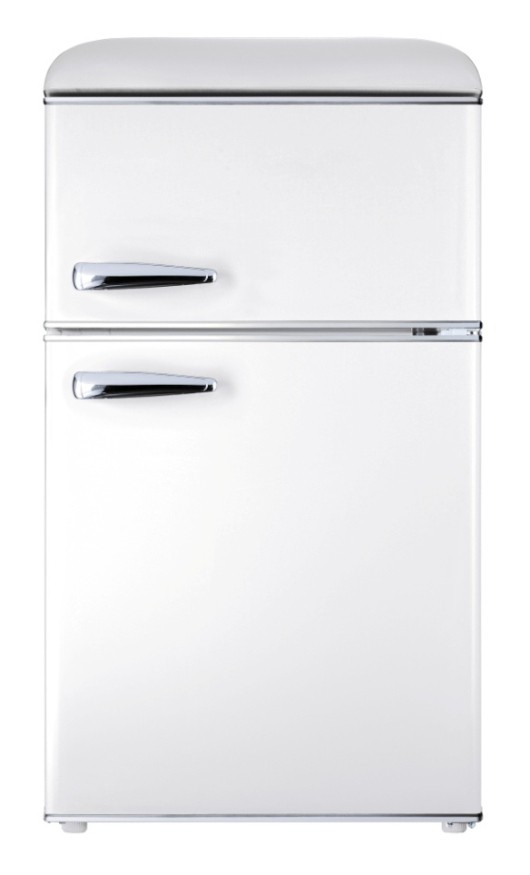

SAFETY & WARNINGS
To ensure your personal safety, please follow the points below:
- This appliance is intended to be used in households and similar applications such as:• Staff kitchen areas in shops, offices, and other working environments• Farmhouses and clients in hotels, motels, and other residential type environments• Bed and breakfast type environments• Catering and other similar non-retail applications
- This appliance is not intended for use by persons (including children) with reduced physical, sensory or mental capabilities or lack of experience and knowledge unless they have been given supervision or instruction concerning the use of the appliance by a person responsible for their safety.
- This appliance may be used by children aged 8 years and above and persons with reduced physical, sensory or mental capabilities or lack of experience and knowledge if they have been given supervision or instruction concerning the use of the appliance in a safe way and understand the hazards involved. Children shall not play with the appliance. Cleaning and user maintenance shall not be made by children without supervision.
- Children should be supervised to ensure that they do not play with the appliance.
- If the power supply cord is damaged, it must be replaced by a Kogan.com technician or a similarly qualified person to avoid a hazard.
- Do not store explosive substances such as aerosol cans with flammable propellants
- Unplug the appliance after use and before carrying out any user maintenance.
- Keep all ventilation openings clear of obstructions.
- Do not use extension cords.
- The refrigerant and cyclopentane foaming material used in this appliance is flammable.
- When unplugging the appliance from the power outlet, grasp the plug and pull on it. Do not put on the cord.
- Please use a dedicated power socket for this appliance. Do not share the outlet with other appliances via a power board or double adapter.
- Do not disassemble or attempt to repair the fridge/freezer yourself. Doing so will void the Kogan.com is not liable for an appliance that has been tampered with.
- Do not touch or move items from the fridge/freezer compartment with wet hands.
- Do not allow animals or pets to climb into or onto the fridge/freezer.
- Do not place heavy objects on top of the fridge/freezer.
- Unplug the unit from the power outlet in the event of a power failure or when cleaning. Avoid plugging the unit back in within the space of 5 minutes after unplugging to avoid damage to the compressor.
- The fridge/freezer should be used only for the storage of household foods. It is not designed for the storage of blood, drugs, or other biological products.
- When the fridge/freezer is being disposed of, the doors should be removed and the power cord should be cut
- The circuitry for the fridge/freezer must be isolated. The area of the cross-section of wire must be larger than 0.75mm2. The power plug should have its own socket, the socket must be ground as the adapter may cause the socket to overheat.
- The voltage and frequency of this product should be 220-240V; 50Hz. Please contact the retailer if the wire is damaged and do not plugin.
- Do not damage the refrigerant circuit.
- Before you throw away your old fridge/freezer.• Take off the doors.• Leave the shelves in place so that children may not easily climb inside• The power cord should be cut to prevent unsafe usage.
- Do not use electrical appliances inside the food storage compartments of the appliance, unless they are of the type recommended specifically by Kogan.com for use with this model.
- Children aged from 3 to 8 years are allowed to load and unload refrigerating appliances.
WARNING: When positioning the appliance, ensure the supply cord is not trapped or damaged.WARNING: Do not locate multiple portable socket outlets or portable power supplies at the rear of the appliance.
![]()
![]()
- Do not expose to open flames, gas, or other harmful substances
- Don’t store inflammable materials such as ether, benzene, LP gas, etc.
- Don’t splash water on the rear of the appliance, for it may cause malfunction or electric shock.
- It is better not to place objects on the top of the appliance, which is magnetic, heavy, or filled with water.
- The refrigerant of this product is R600a, which is inflammable. So, make sure not to damage the cooling system during the transportation and installation.
Note:The information contained in this user guide is accurate at the time of printing. Any changes or updates to the product design cannot be reflected in this user guide.
OVERVIEW
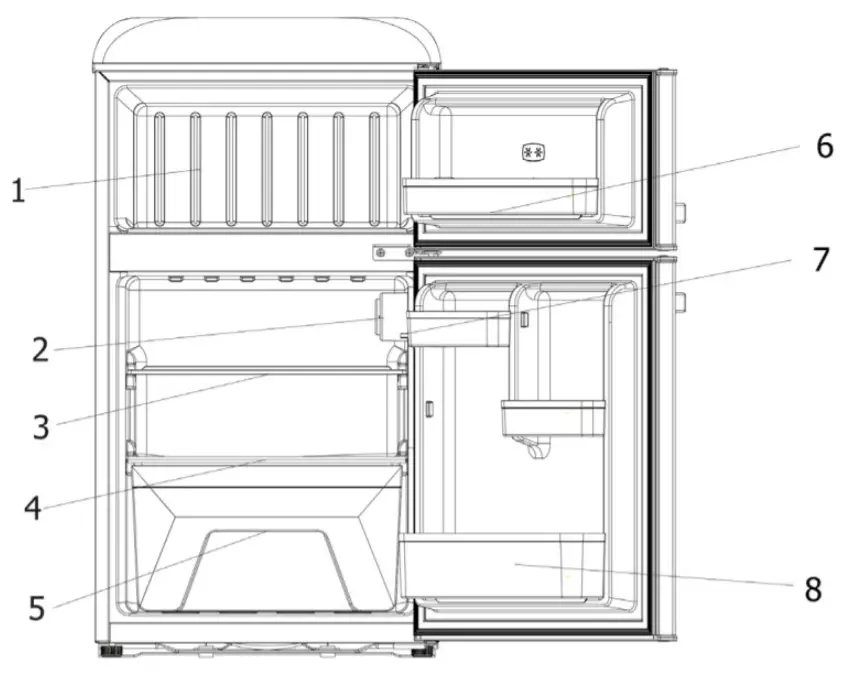

| 1 | Freezer compartment | 5 | Vegetable crisper |
| 2 | Lamp and temperature control dial | 6 | Door shelving |
| 3 | Adjustable shelf | 7 | Lomp switch |
| 4 | Crisper glass cover | 8 | Bottle rock |
- The above image is for reference only and may differ from the final design.
- When using the fridge/freezer for the first time, remove the adhesive tapes of the drawers, shelving, egg troy, and the drain tube plug.
- Do not pull or push the drawers and shelving forcefully during use, as this may cause damage.
- For best energy consumption, set the temperature control as high as it can comfortably be without spoiling food.
- Refrain from opening the fridge/freezer doors often during operation.
INSTALLATION
- The fridge/freezer should be located on a completely flat surface, leave 50-100 mm between each side of the appliance and the wall and leave 300 mm between the top of the appliance and the ceiling.


- Choose a location that is not exposed to sunlight, high temperatures, or humidity.
- Pull out the bottom panel before installation.
- The height and balance of the fridge/freezer can be adjusted by rotating the two front legs. Rotate clockwise to increase the height, rotate anticlockwise to decrease.

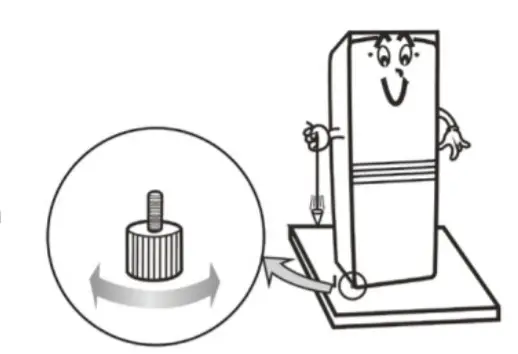
-
The location should be firm and flat. An unsecured position may cause noise and vibration:a, The noise may be increased if the floor is not firm.b, Put a sheet under the appliance for solving the heat emission if you need to position it on the carpet.
- Make sure the adjustable legs are level on the floor and set the fridge/freezer to slope backward slightly to keep the doors tightly closed.
WARNING: When positioning the appliance, ensure the supply cord is not trapped or damaged.Do not locate multiple portable socket-outlets or portable power supplies at the rear of the appliance.
ASSEMBLY
Install the HandlesComponents:


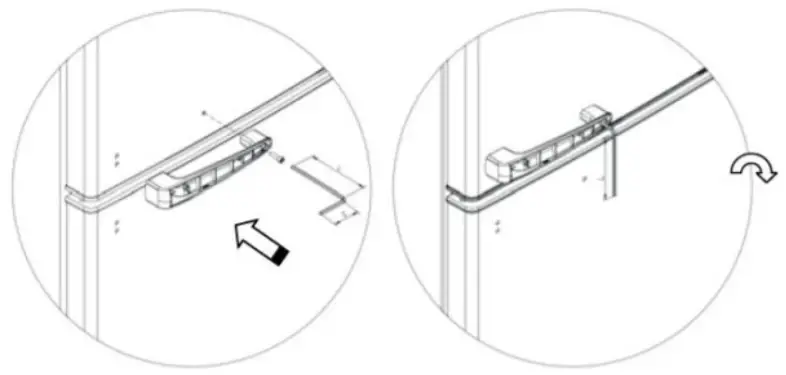



OPERATION
Placement of Food
- There should always be some space between items inside for air circulation.

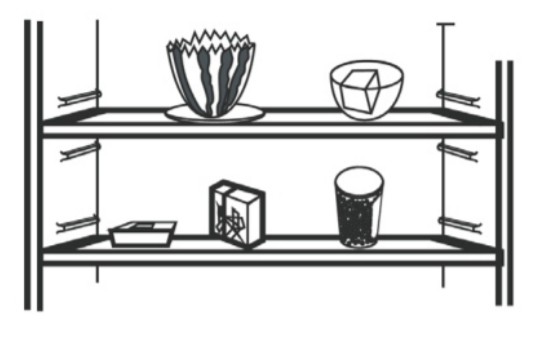
- Food should be kept in sealed packages to avoid becoming dry or odor.

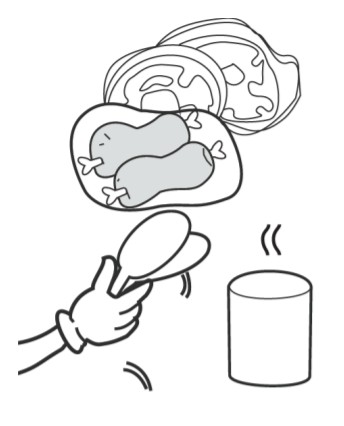
- Hot food should be cooled down before placing into the appliance. Otherwise, interior temperature and electronic consumption will increase.
- Reducing the frequency of the door opening can efficiently slow down electronic consumption.
WARNING: Do not use any electronic equipment inside the appliance.Tips for Use of Refrigerator Compartment
- The common refrigerating temperature of food stored in the refrigerator is from 4°C to 8°C. In this environment, cooked meat cannot be stored for more than 4 days and fruits and vegetables should not exceed one week at most.
- The common temperature of the chilling room is from -1 to 4°C and meat cannot be stored for more than 7 days.
- Meat and seafood need to be packed in different containers and stored for not more than 3 days.
- Raw food and cooked food need to store in different containers. In order to prevent bacterial contamination, raw vegetables and fruits should not be exposed to raw meat or fish. Vegetables and fruits should be wrapped by film and stored in the
To avoid contamination of food, please respect the following instructions:
- Opening the door for long periods can cause a significant increase in the temperature in the compartments of the appliance.
- Regularly clean any surfaces that can come into contact with food, as well as accessible drainage systems.
- Clean water tanks if they have not been used for 48 hours; flush the water system connected to a water supply if water has not been drained for 5 days.
- Store raw meat and fish in suitable containers in the fridge/freezer, so that it is not in contact with or dripping onto other food.
- Two-star frozen-food compartments are suitable for storing pre-frozen food, storing or making ice cream, and making ice cubes.
- One-, two- and three-star compartments are not suitable for the freezing of fresh
- If the refrigerating appliance is left empty for tong periods, switch off, defrost, clean, dry, and leave the door open to prevent mold from developing within the appliance
Instruction for UsageThe temperature of the fridge/freezer can be controlled manually by the temperature control dial.Note that the number shown on the dial does not directly represent the temperature in degrees. The larger the number is, the lower the interior temperature will be.“0” represents OFF; “7” represents the coldest temperature level.Set the dial to “4” to begin with as a ‘normal’ temperature. Then adjust between 4-6 if a lower temperature is needed, or 1-4 if a higher temperature is needed.The temperature in every compartment will be at the lowest degree under this level and it probably makes it below 0°C in the fridge department, so please choose carefully before you use it.
Packing and Moving
- Prior to moving, unpack all food and groceries. For best results, tape shelves and compartments in place. Tape the door closed while moving.
- Do not lift or pull the door or the door handle during transportation.


- When moving, ensure the appliance is never sloped at 45 degrees or more. Avoid any strong vibrations or impact.

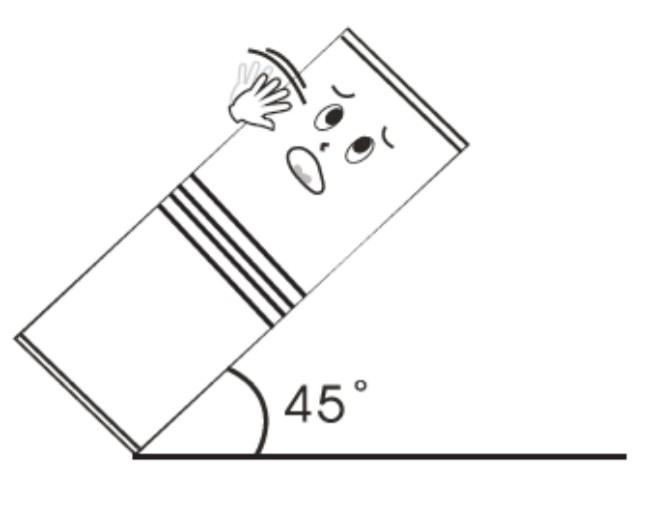
Disconnecting the ApplianceDuring the event of a power failure, even in summer, the fridge/freezer can store food normally for several hours.
- Discontinuation during power failureAfter a power failure, do not put additional food in the appliance and reduce the frequency of door opening. Make ice in a container if the power failure is known beforehand.
- Discontinuation during vacationPlease remove the easily rotten food from the fridge before the short vacation. After confirmation, close the door firmly. For a long vacation, please remove all the food and cut off the power. After defrosting, clean up the liner of the appliance and wipe it dry and leave the door open.
- Stop usingIf the fridge/freezer is stopped after using it for a long time, please unplug from the outlet, remove all food items, and clean the appliance. The door should be kept open in order to prevent unpleasant smells caused by food remnants.
WARNING: Under general conditions do not stop and restart the appliance frequently. After switching off the power, please leave at least 5 minutes before resumption.User Notifications
- Do not splash water on the fridge/freezer, as it will cause oxidation, and Electronic components such as the on/off button should be wiped dry.
- Cleaners such as soap powder, abrasive cleaning powder, alkali cleansers, chemical cloth, thinner, alcohol, acid petroleum product, and hot water should not be used to clean the fridge/freezer as they may damage the painted cover and plastics.
- Smear can damage the interior plastic component, so wipe it as soon as possible.
- Please check the points below after maintenance:1)Is there any damage or loss of the electronic wire?2)Can the plug be put in the socket reliably and smoothly?3)Is the plug heating unconventionally?
WARNING: Please get rid of the gasket of the door before the disposal. Disposed of the appliance should be handled by a professional, as it may be harmful to the environment.
CLEANING & CARE
The appliance should be maintained and cleaned frequently. For your safety, pull the plug out of the socket before cleaning.
- Interior maintenanceClean the interior of the appliance with clean water or neutral soap. Scour it with clean water and wipe it with a piece of dry cloth.
- Maintenance of door gasketIt is easy to damage if the door gaskets are polluted by the stain like oil, sauce and etc., so it is better to clean them carefully.
- Outer maintenanceWipe the dust with a piece of dry cloth, clean it with neutral soap if necessary.
- Light maintenance.The appliance is equipped with a screwing lamp or a long-life LED interior light.(Screwing lamps can be replaced by professionals. Long-life LED is non-replaceable.)
DefrostYou will need to defrost the freezer when the ice exceeds 3-5mm. Take all the foods out of the compartment unplug the appliance. Open the doors and allow the ice to melt wipe with a dry cloth.WARNING: Do not use any other equipment or method to push the defrost process. It may destroy the cooling system.
SPECIFICATIONS
| Climate class | SN/N/ST/T | |
| Electric shock protection type | I | |
| Capacity (L) | Two-star section | 4 |
| Freezer | 22 | |
| Refrigerator | 60 | |
| Voltage (V) | 220-240 | |
| Frequency (Hz) | 50 | |
| Current (A) | 0.6 | |
| Voice [dB(AA | Greater than are equal to 42 | |
| Energy consumption (kW.h/24h) | 0.510 | |
| Refrigerant | R600a/30g | |
| Net Weight (Kg) | 26.5 | |
| Interior temperature(°C) | Freezer | Greater than are equal to -18 |
| Refrigerator | 0-8 | |
| Dimension (mm) | Width | 487 |
| Depth | 592 | |
| Height | 893 |
TROUBLESHOOTING
- The fridge/freezer does not workIt may not be connected to the power supply (plug, power cut, or fuse); Voltage is too low.
- The fridge/freezer does not work efficiently as expectedIt may be caused by heavy frost or by warm temperature setting or by frequently opening the door.
- It is making an unusual noiseIt may be caused by an imbalance please check all feet are of equal size and the ground surface is flat.
- The compressor keeps working for a long periodThe environment temperature may be too high. The doors may be opened frequently or even they are left open. The temperature control knob setting in (4-7) state may increase the working time of the compressor.
- Disgusting odor happensFood with a strong odor should be packed tightly before being put inside the appliance. Please check whether there is any deteriorated item or whether the liners are left dirty for a long time.
- Water leaks from the bottom of the fridge/freezerThe drain tube is jammed. Please use a proper tool to solve it.
- Heavy frost occurs on the rear of the appliancePutting humid or hot food into the appliance may cause this problem. Or it may be caused by heavy environmental moisture.
The following cases are not malfunction
- Moisture may form dew on the outside of the product during the humid season, just get it wiped.
- The flow of refrigerant through the pipeline coil can cause noise.
- It is normal that the sides of the product get warm as a result of the cooling pipeline
- The frame of the appliance will be warm during working by the defrost pipeline inside it.
If the supply cord is damaged, it must be replaced by the manufacturer, its service agent, or similarly qualified persons in order to avoid a hazard.Disposal![]()
![]()
Need more information?We hope that this user guide has given you the assistance needed for a simple setup.For the most up-to-date guide for your product, as well as any additional assistance you may require,head online to help.kogan.com


[xyz-ips snippet=”download-snippet”]

